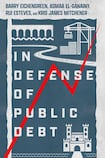
Beginning the morning thinking about our national debt is not an affliction that too many suffer. But for me during our last crisis, every day began with a quick scan of the reaction of financial markets to our national borrowing efforts.
In fairness, it was not an exclusively minority interest. The drumbeat of bond yields dominated media and politics.
Defaulting on our debts was alluring during a time of searing difficulty. Economists became celebrities, all offering competing certainties during a time of bewildering uncertainty.
More than a decade later I have responsibility for that debt. Every morning I receive a formal update on our costs of borrowing. An interest is now replaced with the commitments of ministerial office. But the debates of a decade ago continue. Are national debts affordable? What will happen when interest rates change? How can borrowing be reduced?
However, there are significant differences to this debate. A pandemic has caused increased borrowing. All countries hold higher levels of national debt. Central banks have acted completely differently to the last crisis. Inflation has returned.
In Defense of Public Debt should therefore be of interest not just to ministers for finance. Written by leading (but not celebrity-level) economists, it is very accessible to the general reader.
This book begins with a description of the uses of public debt. They include the ability to fund public services when tax revenue fall, the capacity to fund demand for goods and services to increase employment and investing in future economic growth.
The role of borrowing in funding a transition to a lower carbon future is not discussed. A recent and important debate regarding how levels of public debt can affect growth receives insufficient consideration
The positive role of debt is quickly followed by a warning. The authors write that “the ability to issue debt creates a temptation to put off hard decisions….Borrowing can be relied on excessively, since future generations that lack political voice bear the burden of the government’s obligations.”
This book is a history of two millennia of government borrowing. It begins with the ancient Greek city states such as Syracuse borrowing from their citizens. An early debt crisis involved the Temple of Delians on the island of Delos, struggling to repay debts to other city states.
The scale of sovereign borrowing increased as the stability and number of nation states also grew. England and the Netherlands were at the forefront of this growth. Sophisticated economic institutions in Holland allowed their government to issue long-term debt at low interest rates. The creation of an English constitutional monarchy in 1688 committed the sovereign to repaying debt, leading to a sharp reduction in interest rates.
The aftermath of the Thirty Years War, which ended in 1648, enabled Europe to lead global borrowing due to the number and stability of states.
A further seismic moment occurred when Alexander Hamilton proposed to a young America that state financial commitments should be consolidated into new federal debt. This led to the foundation of the US treasury debt market, spurring the creation of a global economic superpower.
The 19th and 20th centuries saw the scale of borrowing by governments accelerate and the use of this funding radically change. As the authors conclude: “Debt issuance was concentrated in times of war. Now, in addition, they borrowed to finance infrastructure investments designed to foster economic cohesion and growth.”
The book provides a comprehensive overview of modern sovereign borrowing. Developments in Latin American borrowing and the subsequent debt crises of the 1980s and 1990s are fully covered. The agreement of the Maastricht Treaty is then described, obliging European countries to limit their borrowings so that they could share the euro. This history concludes with global efforts to fund an economic response to the pandemic.
This is a thorough and comprehensive history of public debt. Though the title indicates a defence of the use of sovereign debt, the theme is underdeveloped in the historical narrative.
In Defense of Public Debt also makes no reference to the many contemporary arguments about the role and use of public borrowing. There is no discussion of Modern Monetary Theory, the view that there are few constraints to the capacity of governments to spend. And no reference is made to distinguishing between the different forms of expenditure that borrowing can fund.
For example, the role of borrowing in funding a transition to a lower carbon future is not discussed. A recent and important debate regarding how levels of public debt can affect growth receives insufficient consideration.
I fully agree with the conclusion of this book, that “governments should run budget surpluses and retire debt in good times so that they can run deficits and issue debt when the need arises”. But this conclusion is reached without consideration of too many modern policy debates.
In Defense of Public Debt is a thorough and comprehensive history of public debt, but it could be a better defence.
Paschal Donohoe is Minister for Finance and president of the Eurogroup











